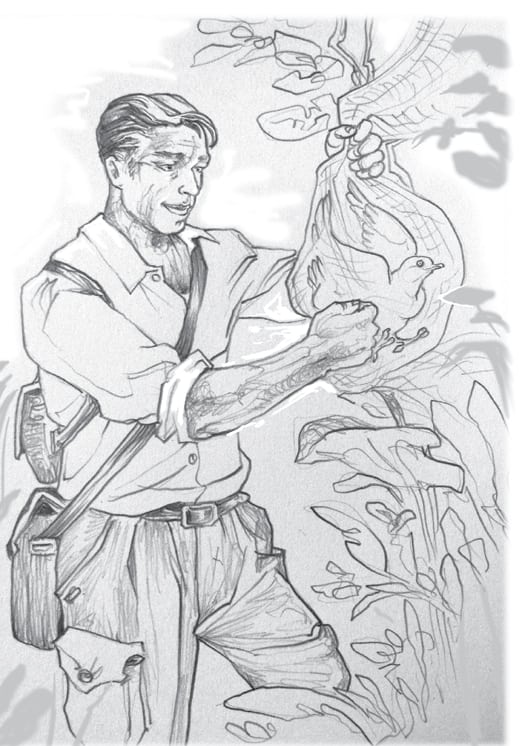George Edward Dobson was an Irish army surgeon stationed in India, known for his work on small mammals, particularly bats and insectivores. Little is known of his personal life, except that he was born to Mr Parke Dobson in County Longford, Ireland on 4th September, 1848 and he died in West Malling, Kent, England, on 26th November 1895. It is evident from his academic background that Dobson had a keen interest in science. He obtained a degree in surgery from Trinity College, Dublin and won numerous awards such as a Gold Medal in Experimental and Natural Science, for his work in medical research.
CHIROPTERA
After his medical training, in 1868, Dobson was posted as an Army Surgeon in Calcutta. He held this post for twenty years till he retired in 1888 as a Surgeon Major. He began working on two groups of mammals, bats (Chiroptera) and insectivores (Insectivora), and in 1871 published his first paper ‘On four new Species of Malayan Bats from the Collection of Dr Stoliczka’ in the Proceedings of the Asiatic Society of Bengal. He then began examining bat specimens from the Indian Museum at Calcutta in 1871. After describing all the bat species from there, he wanted to extend his study and record all the species of bats found in the Indian subcontinent. However, his work was disrupted for a short while by a posting in the remote Andaman Islands in 1872. The stint proved fruitful for Dobson who was able to explore his interest in anthropology by interacting with one of the Negrito tribes of the Islands, the Andamanese. His photographs depicting their various activities and lifestyle drew a great deal of appreciation. He also published two articles in 1875 and 1877 on the Andamanese in the Journal of the Royal Anthropological Institute.
THE MONOGRAPH OF ASIATIC CHIROPTERA
When his assignment in the Andamans ended in 1874, Dobson returned to England for a short spell. While in England he continued his study on bats and examined specimens from museums in Berlin, Leyden and Paris, and Horsfield’s bats from Java. Back in India, he compared the European bats to Indian specimens and in 1876 published his observations in his Monograph of the Asiatic Chiroptera. This monograph contained notes on the fur, form of the ear, dentition, various body measurements and the geographical distribution of 122 species. Of these, 87 species were believed to belong exclusively to Asia. According to Dobson, all the European bats, except for four species, were also found in Asia. Including notes on these four species as well, he stated in the preface to his work that the monograph may also be called “A Monograph of the Asiatic and European Chiroptera”.
With this work Dobson had described several new species of bats including the dawn bat Eonycteris spelaea, Theobald’s tomb bat Taphozous theobaldi, Dobson’s horseshoe bat Rhinolophus yunanensis and the hairy-faced bat Myotis annectans. After the publication of the monograph, he returned to England to work at the British Museum (Natural History) (later the Natural History Museum) in London. His task was to make a compilation of all the bat species in the museum. The Catalogue of the Chiroptera in the Collection of the British Museum was completed in 1878 and it contained detailed descriptions of 400 species of bats. By this time, Dobson was considered an authority on bats, and had corresponded with several important naturalists of the time, including Charles Darwin (on secondary sexual characteristics of bats).

INSECTIVORA
After completing his study on bats, Dobson turned his attention to insectivores, especially focusing his attention on shrews (Family Soricidae). He conducted thorough studies on their structure, nomenclature and classification and in 1881, described Day’s shrew (Suncus dayi) a species endemic to India and threatened today by habitat loss. In 1882, he began his Monograph of the Insectivora, Systematic and Anatomical but it remained incomplete as he fell severely ill. He was able to produce only three parts (1882-1883). He had to resign from his position as an Army Surgeon in 1888 and stop all his scientific work in 1890. After seven long years of suffering, he finally succumbed to his illness on November 26, 1895. One of the most methodical and comprehensive studies carried out on any group of mammals at that time, was thus left unfinished.
At the time of his death Dobson was a member of the Linnean Society of London and a Fellow of the Royal Society, member of the Zoological Society of London and a corresponding member of the Academy of Natural Sciences of Philadelphia and of the Biological Society of Washington.
Suggested reading:
George Edward Dobson. Monograph of the Asiatic Chiroptera: and catalogue of the species of bats in the collection of the Indian Museum. (London: Taylor and Francis, 1876).






